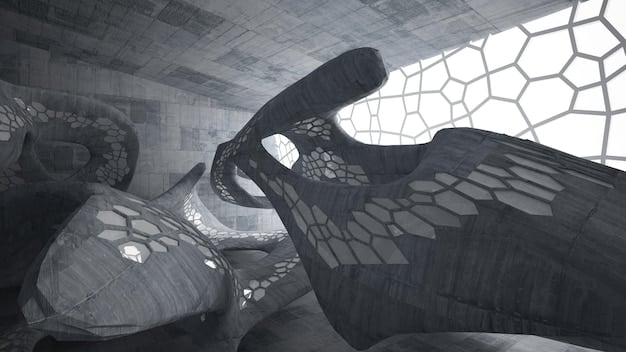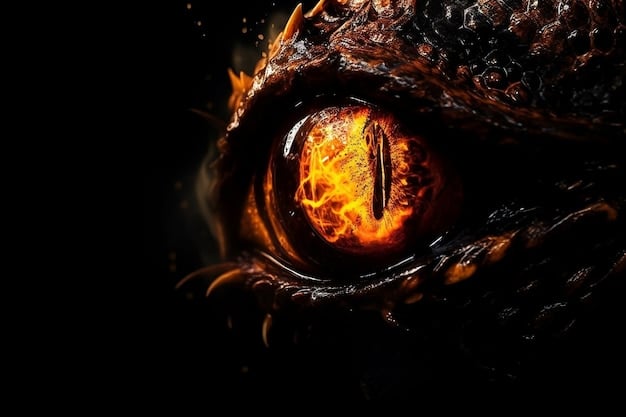HotD Season 2: Rhaenyra & Alicent’s Unexpected Alliance? Theory Analysis

The prospect of Rhaenyra and Alicent uniting against a common enemy in ‘House of the Dragon’ Season 2, while seemingly improbable given their deep-seated animosity and the escalating Dance of the Dragons, is a compelling fan theory stemming from the series’ nuanced character development and George R.R. Martin’s broader themes of shifting allegiances and the greater good, offering a potential groundbreaking narrative deviation from established lore.
‘House of the Dragon’ Season 2 is poised to plunge deeper into the fiery abyss of the Dance of the Dragons, a conflict born from intricate loyalties and betrayals. Yet, amidst the clashing swords and roaring dragons, a persistent and increasingly compelling fan theory has emerged: ‘House of the Dragon’ Season 2: Could Rhaenyra and Alicent Unite Against a Common Enemy? A Fan Theory Analysis delves into the tantalizing possibility of these two bitter rivals forging an unexpected alliance. Could the queens, once inseparable childhood friends, find a reason to set aside their profound animosity for a higher cause?
The Deep Roots of animosity: Understanding Rhaenyra and Alicent’s Feud
The animosity between Rhaenyra Targaryen and Alicent Hightower forms the very crucible of the Dance of the Dragons. Their relationship, once a beacon of youthful friendship, deteriorated into a complex tapestry of political maneuvering, personal betrayal, and tragic misunderstandings. From the outset, their bond was tested by patriarchal pressures and the rigid expectations of the Iron Throne.
Viserys’s decision to name Rhaenyra his heir, an unprecedented move, immediately placed Alicent in a precarious position. Alicent’s marriage to Viserys, orchestrated by her opportunistic father Otto Hightower, was the first major fissure. It wasn’t a choice born of love but of duty and ambition, further entwining her fate with the very institution that threatened Rhaenyra’s claim. This political marriage forced Alicent into a role of rivalry, even if her early intentions were simply to support her family.
The Seeds of Resentment and Misunderstanding
The slow burn of resentment began with a series of slights and misinterpretations. Rhaenyra’s perceived disregard for decorum and her defiant personality often clashed with Alicent’s growing traditionalism and sense of duty. The infamous green dress, a stark visual representation of Alicent’s allegiance to the Hightowers and a repudiation of Rhaenyra’s black, solidified their opposing factions. Each queen came to view the other through a lens of perceived injustice and threat.
The tragic loss of loved ones further fueled their hatred. Alicent saw Rhaenyra as responsible for the deaths of her children, like Lucerys’s demise directly at Aemond’s hand, which she blamed Rhaenyra’s actions for eliciting. Rhaenyra, in turn, lost her own children and felt constantly undermined by Alicent’s faction, blaming them for challenging her rightful succession. The emotional toll of these losses amplified their personal feud into a full-blown civil war.
- 👑 Betrayal of Friendship: The shift from intimate peers to political adversaries, fueled by external pressures.
- ⚡ Succession Crisis: Viserys’s ill-defined succession plan, caught between tradition and personal desire, set the stage.
- 💔 Personal Losses: Each queen suffered immense personal tragedies, deepening their individual and collective grievances.
- 🐍 Political Manipulation: Otto Hightower’s constant whisperings and Daemon Targaryen’s provocations intensified the divide.
Examining the initial stages of their conflict reveals that while both women were driven by ambition and a desire to protect their children, their paths diverged dramatically. Their common ground, once solid, eroded piece by piece, replaced by a chasm of mistrust and animosity. Understanding this deep-seated hatred is crucial to appreciating the magnitude of any potential future alliance.
Shared Vulnerabilities and the Greater Threat: Why an Alliance Might Emerge
Despite the seemingly insurmountable wall of hatred between Rhaenyra and Alicent, the brutal realities of war have a peculiar way of forcing uncomfortable truths and unexpected alliances. As the Dance of the Dragons progresses, both queens face mounting pressures and shared vulnerabilities that could, theoretically, pave the way for a temporary, fragile truce against a common, more existential threat.
The primary driver for such an alliance would likely be the realization that their conflict, while deeply personal, is also destroying the very kingdom they both claim to champion. The constant bloodshed, the devastation of the realm, and the dwindling resources would inevitably take a toll on both sides. George R.R. Martin often explores themes where characters must set aside personal vendettas for the greater good, hinting that such a pivot is not entirely alien to his narrative style. The prophecies of the Long Night and the threat beyond the Wall, though distant to their current conflict, could also become a unifying factor.

The Cost of Continued War and External Pressures
As the war escalates, the human cost becomes undeniable. Both Rhaenyra and Alicent have lost children, allies, and face increasingly desperate circumstances. The toll on their respective houses—Blacks and Greens—is immense. This shared experience of suffering could, however subtly, open a crack in their hardened resolve. The exhaustion of war might lead them to seek a path that protects what little remains of their families and the realm.
Moreover, external forces could emerge. While not explicitly detailed in the show yet, the lore of Westeros is replete with larger threats, such as the Others or other foreign powers. If a truly overwhelming common enemy were to appear, perhaps a resurgence of the Others from beyond the Wall, or even a third party aiming to capitalize on the weakened state of Westeros, it could force both sides to recognize the futility of their internal strife. This “greater evil” scenario is a classic narrative device for unexpected team-ups.
- 💸 Economic Ruin: The war is depleting the wealth and resources of the Seven Kingdoms, affecting all.
- 🛡️ External Threats: The possibility of Essosi powers or the Others exploiting Westeros’s weakness.
- 📉 Loss of Allies: Both sides are losing key supporters, thinning their ranks and weakening their positions.
- 👪 Protecting Descendants: A shared desire to safeguard the remaining Targaryen line, regardless of faction.
The children of both queens, particularly those who have survived, might also inadvertently become a catalyst. Seeing their descendants caught in the brutal crossfire could prompt a desperate attempt to find a non-violent resolution or at least a temporary cessation of hostilities. While their rivalry is deeply personal, it is ultimately about securing their legacies, and if continued conflict threatens those very legacies, a re-evaluation might occur. The series has already shown flashes of their past camaraderie, suggesting that buried beneath layers of resentment, a sliver of their former bond might still exist, waiting for the right external pressure to resurface.
Lore vs. Adaptation: How the Show Might Deviate from ‘Fire & Blood’
George R.R. Martin’s “Fire & Blood” serves as the primary source material for ‘House of the Dragon’, detailing the history of the Targaryen dynasty. However, it’s crucial to remember that “Fire & Blood” is presented as a historical account, often with conflicting narratives from different septons and maesters, leaving room for interpretation. Adaptations, especially those striving for dramatic impact and modern resonance, frequently take liberties with source material to enhance character development, streamline plots, or create unexpected turns.
The showrunners of ‘House of the Dragon’ have already demonstrated a willingness to expand upon and even subtly alter the documented history to serve their narrative vision. The portrayal of Rhaenyra and Alicent’s early friendship, for instance, significantly deepens their bond and the tragedy of its fracture, which in “Fire & Blood” is more summarily presented. This deepening of their personal connection establishes a foundation upon which a future, albeit fragile, reconciliation or alliance could be built.
Enhanced Character Arcs and Narrative Choices
By giving Rhaenyra and Alicent more humanity and internal conflict, the series makes them more complex than their historical counterparts might appear. This complexity allows for greater flexibility in their character arcs. A direct adaptation of every detail from “Fire & Blood” would arguably be less compelling as a dramatic television series. The show has already chosen to make certain characters more sympathetic or nuanced than their written versions, and this trend could extend to pivotal plot points.
For example, “Fire & Blood” largely depicts Alicent as a hardened antagonist. The show, however, offers glimpses into her struggles, her genuine love for Viserys, and her increasing distress over the war. Similarly, Rhaenyra, while strong, is shown grappling with significant losses and the heavy burden of leadership. These nuanced portrayals set the stage for possibilities not explicitly detailed in the book but plausible within the established characterizations. The potential for an alliance, even a fleeting one, offers a powerful dramatic beat that would resonate deeply with viewers who have watched their relationship unravel.
- 📖 “Fire & Blood” as Historical Account: Written from multiple, potentially biased, perspectives, allowing for show interpretation.
- ✍️ Showrunners’ Vision: Intent to deepen character relationships and enhance dramatic tension beyond mere historical recounting.
- 📈 Character Nuance: The series has added layers of complexity and sympathy to both Rhaenyra and Alicent not always present in the book.
- 🔄 Narrative Fidelity vs. Dramatic Impact: The show balances faithfulness to lore with the need for compelling, television-friendly storytelling.
A deviation concerning an alliance would be significant, yet not entirely without precedent within the broader “A Song of Ice and Fire” universe. George R.R. Martin himself is known for subverting expectations and exploring grey areas in morality and allegiance. While “Fire & Blood” does not explicitly foresee such a union, the adaptation has the liberty to suggest what “might have been” or what could emerge from the intense pressures of war. This creative freedom makes the fan theory all the more plausible within the show’s specific narrative framework.
The Cataclysmic Events Leading to Potential Unity
For a union, however temporary, between Rhaenyra and Alicent to occur, the events of Season 2 would need to escalate to a level of destruction so profound that their personal grievances are overshadowed by the immediate threat to their very survival, or to the survival of the Targaryen legacy. The trajectory of the Dance of the Dragons is one of ever-increasing violence and devastation, making such a scenario grimly plausible.
The second season is expected to witness the full brutality of the war, including key battles and strategic moves that decimate both sides. As the war claims more lives, particularly those of their remaining family members and loyal supporters, the notion of “winning” becomes increasingly hollow. The realization that their children are dying for a claim that may ultimately doom them all could be a powerful motivator for both queens to rethink their absolute opposition.
Escalating War and Unforeseen Consequences
The war’s initial stages are already marked by significant losses, such as Lucerys and Arrax’s deaths. Season 2 promises further tragedies, including perhaps the Battle of the Gullet or the Blood and Cheese incident. Each loss, while fueling vengeance in the short term, also contributes to an overarching sense of despair and exhaustion. The queens might begin to see that continued conflict only serves to weaken their house against future, unknown threats.
Consider the potential for a third party to emerge, perhaps opportunistic lords or even a force from outside Westeros, taking advantage of the Targaryens’ self-destruction. Such a development would undoubtedly present a new common enemy, one that neither Rhaenyra nor Alicent could hope to defeat alone. The threat of total annihilation, not just of their faction but of their entire royal lineage and the stability of the Seven Kingdoms, could act as the ultimate catalyst for a desperate, pragmatic alliance.
- 🔥 Intensified Warfare: Major battles and strategic maneuvers leading to unprecedented casualties.
- 🏰 Destruction of Infrastructure: The realm itself suffering immense damage, affecting resources and public morale.
- 💀 Further Family Losses: Continuing deaths of key family members, forcing a re-evaluation of the war’s purpose.
- 🤝 Desperation for Survival: The recognition that continued conflict ensures mutual destruction, not victory.
The idea of a shared tragedy or a mutual external threat forcing their hands is a potent narrative tool. It shifts the focus from personal enmity to collective survival. The nature of these cataclysmic events would need to be profound enough to challenge their core beliefs and force them into a desperate, perhaps reluctant, collaboration. It would be a testament to their leadership, however flawed, if they could prioritize the realm over their personal vendetta, even for a brief, strategic moment.
The Difficulties and Downsides of Such a Union
While the prospect of Rhaenyra and Alicent uniting offers compelling dramatic potential, it is an alliance fraught with immense difficulties and significant downsides. Their hatred is deeply ingrained, extending beyond mere political differences to profound personal betrayals and the deaths of loved ones. Overcoming such a chasm of animosity, even for a common cause, would be a monumental task, likely requiring more than just a passing external threat.
The psychological toll of forgiving, or even tolerating, the person you hold responsible for your greatest losses would be immense. Each queen represents everything the other despises or fears. Rhaenyra views Alicent as a usurper orchestrated by her father, while Alicent sees Rhaenyra as an illegitimate heir whose disregard for tradition brought ruin upon their families. These deeply held beliefs are unlikely to simply vanish, even in the face of a greater enemy.
Maintaining Trust and Consolidating Power
Even if a reluctant agreement were reached, the issue of trust would plague any alliance. Both queens have experienced betrayal, directly or indirectly, at the hands of the other’s faction. Who would lead? How would power be shared or consolidated? The underlying tension and suspicion would persist, making coordination difficult and effective unity almost impossible. Loyalists on both sides, who have fought and bled for their queens, would also struggle to accept such a swift and radical shift in allegiance.
Furthermore, an alliance might not be seen as a strength but as a weakness by external parties. It could be perceived as a sign of desperation, inviting further opportunistic attacks. The very act of unity could also spark internal rebellions among those who refuse to serve alongside their former enemies. The political landscape of Westeros is treacherous, and pragmatism does not always translate into popularity or sustained peace. The risk of one queen betraying the other at the first sign of advantage would always loom large, making any collaborative effort inherently risky.
- ⚔️ Deep-Seated Animosity: Personal hatred and blame make genuine cooperation nearly impossible.
- 🚫 Trust Deficit: Years of conflict and betrayal have eradicated any basis for mutual trust.
- 👑 Leadership Dispute: The fundamental question of who rules Westeros would remain unresolved.
- 😤 Loyalist Resistance: Retainer and bannermen on both sides likely to resist or outright reject conciliation.
The very nature of their conflict suggests that an alliance, if it happens, would be a temporary, tactical maneuver born out of extreme duress, rather than a genuine reconciliation. The downsides, including the potential for internal dissent, continued mistrust, and the risk of further betrayal, might outweigh the benefits, especially if the perceived common enemy is not sufficiently overwhelming to silence their bitter history entirely. Such a union would represent a fragile and dangerous gamble, characteristic of the desperate measures taken during wartime.
Fan Theories and Their Narrative Impact on the Fandom
Fan theories, such as the compelling idea of Rhaenyra and Alicent uniting against a common enemy, play a crucial role in shaping the collective experience of a dedicated fandom. They are not merely speculative musings but active contributions to the ongoing narrative conversation. These theories allow fans to engage deeply with the material, explore alternative outcomes, and project their understanding of character motivations and plot trajectories onto future seasons.
The vibrant discussion around these theories builds anticipation, keeps the show relevant between seasons, and fosters a strong sense of community among viewers. When a theory, like this potential alliance, gains traction, it highlights the perceived possibilities within the show’s established universe and demonstrates the audience’s investment in its characters and overarching themes. It transforms passive viewing into active, analytical participation.
The Power of Speculation and Community Building
Fan theories thrive on the ambiguities and narrative potential embedded within complex shows like ‘House of the Dragon’. They often spring from careful re-watches, detailed analyses of dialogue and visual cues, and a deep understanding of the source material. The collective effort of dissecting episodes and lore creates a richer, multi-layered viewing experience, where every scene is scrutinized for hidden meanings or future implications. This process not only entertains but also hones critical thinking skills within the fandom.
The act of sharing and debating theories on forums, social media, and dedicated fan sites strengthens the community. It provides a platform for like-minded individuals to connect, debate, and even respectfully disagree, fostering a sense of belonging. When a theory proves correct, it rewards the collective investigative effort of the fandom, validating their engagement. Even when incorrect, the process of theorizing enriches the discussion and deepens appreciation for the showrunners’ eventual creative choices.
- 💡 Enhanced Engagement: Theories keep fans actively thinking about and discussing the show long after episodes air.
- 🗣️ Community Cohesion: Debating theories fosters interaction and a sense of shared experience among viewers.
- 🔍 Deeper Analysis: Encourages meticulous examination of plot points, character development, and source material.
- 🔮 Anticipation Generation: Building excitement for upcoming seasons and narrative revelations.
The ‘House of the Dragon’ fandom, steeped in the rich lore of Westeros, is particularly adept at this kind of speculative engagement. The complex political landscape, the morally ambiguous characters, and the “historical” nature of “Fire & Blood”—which inherently invites different interpretations—provide fertile ground for imaginative theorizing. This specific theory about Rhaenyra and Alicent uniting speaks to the desire for a resolution, however unlikely, to their tragic conflict, tapping into the audience’s emotional investment in their relationship.
What We Can Expect from ‘House of the Dragon’ Season 2
‘House of the Dragon’ Season 2 is poised to deliver on the promise of escalating conflict, delving deeper into the brutal realities of the Dance of the Dragons. Following the devastating events of the Season 1 finale, particularly the death of Lucerys Velaryon and Arrax, the war is no longer merely a political struggle but a deeply personal vendetta, charged with grief and a thirst for vengeance. Viewers should prepare for a season defined by intense battles, shifting allegiances, and profound character development under duress.
The narrative is expected to focus on the immediate aftermath of Lucerys’s death, which pushes Rhaenyra and Daemon to retaliate in brutal fashion. This act of “blood for blood” will undoubtedly propel the conflict into an even more destructive phase, solidifying battle lines and testing the resolve of both the Blacks and the Greens. We anticipate witnessing the full strategic and tactical scope of the war, including dragon-on-dragon combat, naval engagements, and sieges that will further devastate Westeros.

Key Plot Developments and Character Arcs
Several key plot points from “Fire & Blood” are likely to form the backbone of Season 2. The infamous “Blood and Cheese” incident, a brutal retaliation orchestrated by Daemon, is widely anticipated and will further plunge the realm into darkness. The season will also likely explore the recruitment of new dragonriders, the forging of desperate alliances with various noble houses, and the continued struggle for control over strategic locations.
Character development will be paramount. Rhaenyra’s grief and transformation into a more hardened queen are central to her arc. Alicent, too, will face the consequences of her choices and the escalating violence, potentially grappling with the moral compromises she has made. The younger generation, especially Aegon II, Helaena, and Aemond, will be pushed to their limits, forced to confront the harsh realities of war and the heavy burden of their Targaryen heritage. The season will undoubtedly explore the psychological toll of such conflict on all involved factions, leaving no one unscathed.
- 🐉 Intense Dragon Combat: Expect more large-scale aerial battles as both sides deploy their formidable beasts.
- 💔 Escalating Violence and Revenge: The cycle of “an eye for an eye” leading to more tragic losses.
- 🏰 Strategic Engagements: Focus on key battles, sieges, and political maneuvering for control of Westeros.
- 🎭 Deepened Character Arcs: Queens and princes facing immense pressure, leading to significant personal transformations.
While the fan theory of an unlikely alliance between Rhaenyra and Alicent remains tantalizing, the immediate outlook for Season 2 is one of uncompromising warfare and brutal consequences. The show is set to fully immerse viewers in the tragedy of the Dance of the Dragons, exploring its destructive impact on both the Targaryen family and the realm. The path to any sort of unity, if it exists, would certainly be wrought with fire and blood, forged in the crucible of absolute despair and mutual destruction.
| Key Point | Brief Description |
|---|---|
| 🤝 Potential Unity | Despite animosity, a shared major threat or mutual destruction could force Rhaenyra and Alicent to cooperate. |
| 🔥 War’s Escalation | Season 2 promises intense battles and tragic losses, pushing both sides to their limits. |
| 📜 Lore vs. Show | The show has shown willingness to adapt and expand on “Fire & Blood” for dramatic effect. |
| 🤔 Fan Theory Impact | Speculation enriches fandom engagement and builds anticipation for future plot twists. |
Frequently Asked Questions About House of the Dragon Season 2
▼
Fans theorize a potential alliance due to increasing shared suffering from the war, the possibility of a greater external threat emerging, and the show’s demonstrated willingness to diverge from “Fire & Blood” to deepen character arcs. Their complex history, while antagonistic, also hints at a past bond that could, under extreme duress, resurface for strategic purposes.
▼
Season 2 is expected to focus on the full escalation of the Dance of the Dragons. Key events include likely retaliation for Lucerys’s death, such as the infamous “Blood and Cheese” incident, intensified dragon battles, strategic political maneuvers, and the devastating impact of the civil war on the realm and its people, pushing both factions to their limits.
▼
“Fire & Blood” serves as the historical source, but the show takes liberties to enhance dramatic impact and character development. It portrays Rhaenyra and Alicent’s early friendship more deeply and adds nuance to their motivations, allowing for potential narrative deviations like a temporary alliance that aren’t explicitly detailed in the book’s historical accounts.
▼
An alliance would face immense challenges due to their deep-seated animosity, past betrayals, and the deaths of their children. Trust would be almost non-existent, and determining leadership or power-sharing would be contentious. Additionally, loyalists on both sides would likely resist such a union, making it inherently fragile and susceptible to internal dissent or renewed conflict.
▼
Fan speculation is vital as it fosters deep engagement, keeps the show relevant between seasons, and builds community among viewers. It encourages detailed analysis of the narrative and characters, leading to a richer understanding and appreciation of the series. Theories create anticipation and allow fans to actively participate in the larger storytelling experience.
Conclusion
The journey through the intricate web of ‘House of the Dragon’ Season 2, particularly the speculative possibility of Rhaenyra and Alicent uniting, underscores the profound impact of fan theories on our engagement with complex narratives. While history, as told in “Fire & Blood,” often points to an unyielding conflict, the show’s nuanced character development leaves room for a more dramatic and emotionally resonant path. Whether such an alliance materializes or not, the continued discussions and theories enrich the viewing experience, preparing us for a season that promises to be as heartbreakingly personal as it is epically devastating, pushing the characters and the realm to their absolute limits.





